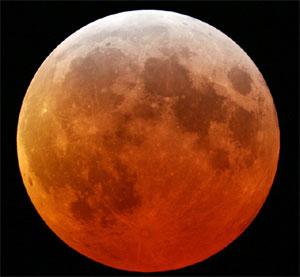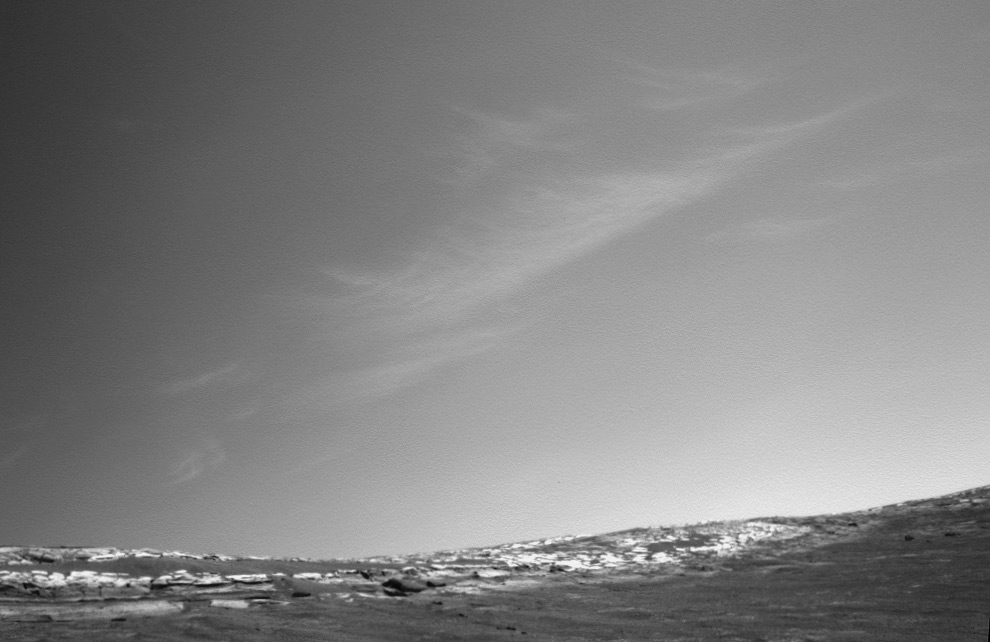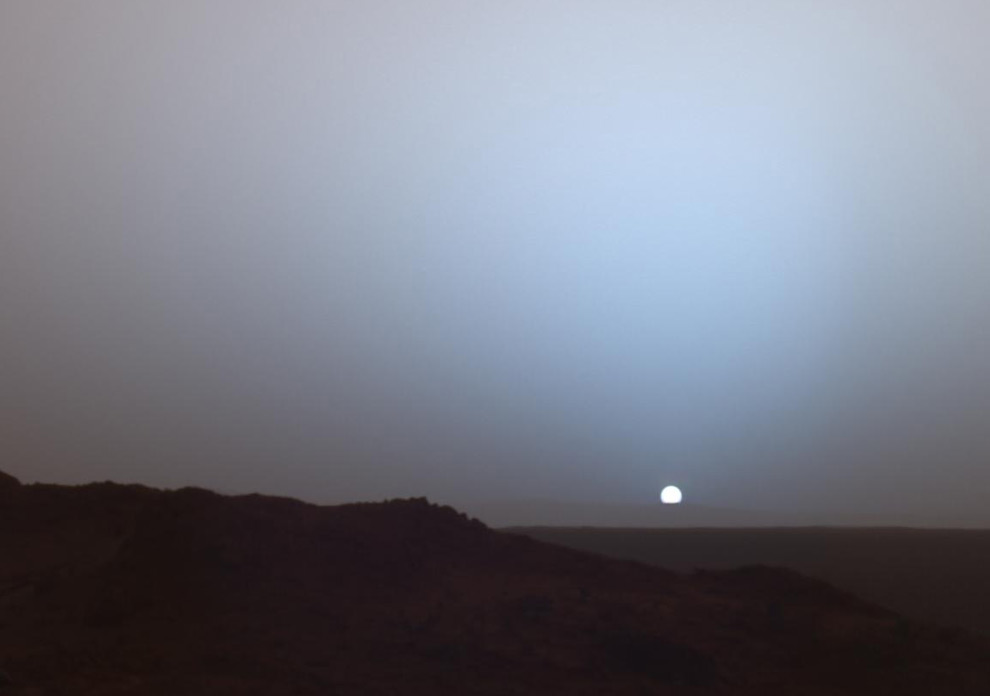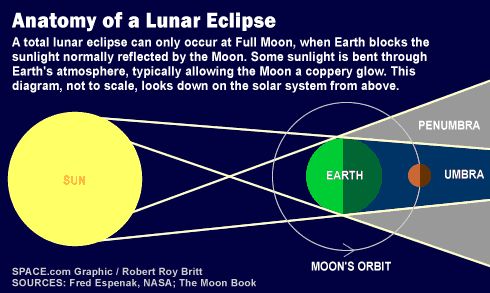 The rosy glow of a lunar eclipse helped astronomers capture the Earth's transmission spectrum.Daniel Lopez
The rosy glow of a lunar eclipse helped astronomers capture the Earth's transmission spectrum.Daniel LopezPosted on 06/11/2009 11:19:55 PM PDT by neverdem
Lunar eclipse paints portrait of Earth that could aid hunt for distant habitable planets.
 The rosy glow of a lunar eclipse helped astronomers capture the Earth's transmission spectrum.Daniel Lopez
The rosy glow of a lunar eclipse helped astronomers capture the Earth's transmission spectrum.Daniel LopezAstronomers have seen what the Earth's atmosphere might look like from outer space by using the Moon as a giant mirror. Sunlight that bounced back from the Moon carried a fingerprint of the Earth's atmosphere that could help astronomers determine if the extrasolar planets they're finding harbour life.
The astronomers, at Spain's Institute of Astrophysics of the Canary Islands, made their observations on 16 August 2008 during a lunar eclipse — in which the Moon moves into Earth's shadow. Even when the Moon is totally eclipsed by Earth, it is still bathed in a dim red light — from sunlight that has been bent as it passes through the edge of Earth's atmosphere. Using Earth-based telescopes, the astronomers detected some of this light after it bounced back from the Moon, and captured a 'transmission spectrum' of the light that had passed through Earth's atmospheric halo.
Because gases in Earth's atmosphere absorb certain wavelengths of light, the astronomers were able to pick out key biosignatures in the spectrum — gases such as methane and oxygen that are associated with life on Earth. But they were surprised to find signatures that they expected to be too weak to detect: evidence of Earth's protective ionosphere, which absorbs some of the Sun's highest energy photons, and evidence of nitrogen, which makes up the bulk of the atmosphere but is difficult to detect.
"We find that these signatures are actually much stronger than the models predicted," says institute astronomer Enric Pallé, lead author of a study published today in Nature1. "They will be easier to detect on an exosolar planet."
Astronomers believe that a planet of similar size and mass to Earth could be discovered within a few years. But the next step in the discovery process — characterizing such a planet's atmosphere to see if it is at all like Earth's — will depend on distinguishing light from the planet from light from its star. Pallé says that this characterization will be done best by capturing a planet's transmission spectra rather than by trying to capture starlight reflected by the planet's atmosphere.
This suggests that the $4.9 billion James Webb Space Telescope (JWST), due for launch in 2014 — which will be able to do transmission spectroscopy — might be better able to characterize an extrasolar 'Earth' than its proposed successor. That instrument, an even more expensive space telescope, will require some means of blocking the light from a star in order to detect light reflected by its planet.
Of over 350 extrasolar planets discovered so far, about one in six were found when they eclipsed their parent stars, blocking just enough starlight to be noticed as a temporary dip in the light gathered by the telescope. Such detection of these 'transiting' planets is useful not only because it can discern the planet's size, but also because it offers the chance to look for the tiny absorption dips in the transmission spectra caused by atmospheric gases. Looking for transiting extrasolar planets is analogous to Pallé and colleagues' technique — using the Moon as a mirror to watch Earth transit the Sun.
There are easier ways of capturing Earth's transmission spectrum — for example, by aiming a telescope toward a sunset, when the light passes through more of the atmosphere than it does at other times of the day, or using near-Earth climate satellites. But spectra gathered in these ways are too localized and too precise to build up the fuzzy big picture needed for comparison with the distant planetary dots turned up by astronomers. Using the Moon to view Earth recreates the basic geometry of exoplanet searches, as well as averaging the effect across the entire atmosphere.
Even with the JWST, however, finding extrasolar 'Earths' will be tough. Pallé says that any such planet's parent star would have to be within about 30 light years and would have to be a dwarf. Transits of dwarf stars provide bigger signals, because the planet blots out proportionally more of the star's disk. The habitable zone for planets in orbit around cool dwarf stars is also much closer in, so the period of revolution is shorter — affording astronomers more frequent transits to observe.
But Wes Traub, an astrophysicist at the Jet Propulsion Laboratory in Pasadena, California, says that there are probably only a few planets that satisfy these conditions. Viewed from Earth, planets transit their stars only about 1% the time. "For every one of them, there are 99 more out there that we cannot see by that technique," he says. For this reason, he wants to build a space-based successor to the JWST, roughly the same size but designed to gather the reflected light of the star in addition to the transmission spectra gleaned during transits. That will mean resolving complicated issues with the shades needed to blot out the parent star's light. But it will open up a much wider population of targets. "They're hiding from view," says Traub, "but they're out there."
G-d already tells us what the destiny of this world is. We won’t need to look for other planets. It simply isn’t a part of G-ds plan that we live on other planets.
So I guess it's OK to visit them.
That just looks like Mars.
All that depends on whether this God exists/ once existed or not.
No sale.
Some of them are really not much different than home. No reason to be afraid.
Here's one of my favorites images.

Clouds above the rim of "Endurance Crater" in this image from NASA's Mars Exploration Rover Opportunity. These clouds occur in a region of strong vertical shear. The cloud particles (ice in this martian case) fall out, and get dragged along away from the location where they originally condensed, forming characteristic streamers. Opportunity took this picture with its navigation camera during the rover's 269th martian day (Oct. 26, 2004). (NASA/JPL)

On May 19th, 2005, NASA's Mars Exploration Rover Spirit captured this stunning view as the Sun sank below the rim of Gusev crater on Mars. This Panoramic Camera mosaic was taken around 6:07 in the evening of the rover's 489th martian day, or sol. Spirit was commanded to stay awake briefly after sending that sol's data to the Mars Odyssey orbiter just before sunset. The image is a false color composite, showing the sky similar to what a human would see, but with the colors slightly exaggerated. (NASA/JPL/Texas A&M/Cornell)
“With God, all things are possible.”
I thought God made us smart enuf to get off this rock and carry the Word to all places and to all men.
True, but G-d is not a liar. We Jews are commanded to live in the land of Israel. In the Messianic era we aren’t even going to live outside Israel let alone other planets.
Take a longer view... but I’ll agree that we have many trials to be fired by, before we get to where we’re going.
In the mean time, what better use of our God given senses, than to study His creation?
What part of Israel are you in?
What NASA doesn't want to say openly is that Mars has a blue sky.

Sorry fella, that’s just painfully silly.
So why would God put possibly quintillions of planets out there?
Obviously, Tatooine. I do miss it so.
I believe it is God’s plan that we travel to other worlds, and - as well as study his amazing creation - we will find the “sheep of the other sheepfolds.”
Disclaimer: Opinions posted on Free Republic are those of the individual posters and do not necessarily represent the opinion of Free Republic or its management. All materials posted herein are protected by copyright law and the exemption for fair use of copyrighted works.